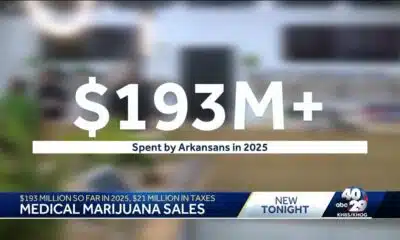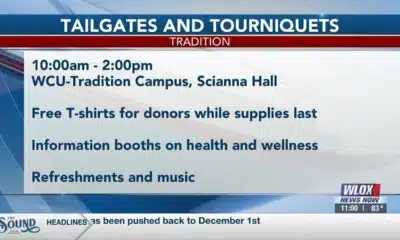News from the South - Alabama News Feed
Get rid of FEMA? Trump-appointed group to look at shifting disaster response to states • Alabama Reflector
Get rid of FEMA? Trump-appointed group to look at shifting disaster response to states
by Jennifer Shutt, Alabama Reflector
January 27, 2025
WASHINGTON — Governors and state legislatures may have to bolster their natural disaster response and recovery efforts in the coming years as President Donald Trump looks for ways to shift the federal government’s role onto states.
Trump, who proposed doing away with the Federal Emergency Management Agency altogether last week, has since established a 20-member committee via executive order to review the agency and propose ways to overhaul its work.
The fate of the National Flood Insurance Program, managed by FEMA and relied on by more than 4.7 million homeowners, will also be up in the air as the process gets underway.
“I think, frankly, FEMA is not good,” Trump said in North Carolina on Friday. “I think when you have a problem like this, I think you want to go and — whether it’s a Democrat or a Republican governor, you want to use your state to fix it and not waste time calling FEMA.”
Trump said he planned to recommend that “FEMA go away and we pay directly — we pay a percentage to the state.”
“But the state should fix this,” Trump said. “If the state did this from the beginning, it would have been a lot better situation.”
‘Full-scale review’ for FEMA
Trump’s executive order states that “Americans deserve an immediate, effective, and impartial response to and recovery from disasters.”
“FEMA therefore requires a full-scale review, by individuals highly experienced at effective disaster response and recovery, who shall recommend to the President improvements or structural changes to promote the national interest and enable national resilience,” the executive order says.
Homeland Security Secretary Kristi Noem and Defense Secretary Pete Hegseth will co-chair the 20-member group. The White House did not respond to a question as to when Trump would name the other members.
The council is supposed to release a report later this year comparing FEMA’s response to various natural disasters with how the state affected by the emergency responded. The report is also expected to include how states responded to natural disasters before then-President Jimmy Carter signed in executive order in 1979 establishing FEMA.
U.S. House Speaker Mike Johnson said during a press conference Monday that he supports reviewing how FEMA operates, but he stopped short of eliminating the agency.
“In my experience, it is very often the case that local workers, people who are working through FEMA, do a pretty good job,” Johnson said. “But often, it’s the leadership at the top that can affect the outcome of how a disaster is handled.”
Johnson said no department or agency should be considered out of bounds for evaluation as Trump looks to “make the government more efficient and effective” and Republican lawmakers look for ways “to limit the size and scope of government.”
“FEMA has been a partner, but they probably could be a better partner,” Johnson said.
Let states run response
Republican U.S. Sen. Lindsey Graham said Monday that Trump’s preferred approach would be to let states run their own emergency response and be reimbursed with federal dollars.
“FEMA is frustrating at times,” Graham told reporters in Columbia, S.C. “I’d like to make it easier to help people with disaster relief.”
Graham expects anything that comes out of the study to land somewhere in the middle — not completely eliminating the federal agency but cutting through some of the red tape.
“If you want to look at FEMA, reshape FEMA, to make it more effective, count me in,” Graham said.
Congress appropriated $25.3 billion for FEMA in the last full-year spending bill for the agency, which was $72.9 million less than its previous funding level and $267.7 million less than then-President Joe Biden’s budget request, according to a House GOP summary.
Lawmakers provided an additional $29 billion for FEMA’s disaster relief fund in an emergency spending bill that Congress approved in late December.
Democratic Governors Association national press secretary Devon Cruz wrote in a statement the GOP was “floating dangerous ideas.”
“When natural disasters hit, Democratic governors have been a leading example of putting politics aside, and helping families rebuild and recover,” Cruz wrote. “Now, Donald Trump and Congressional Republicans are shamelessly politicizing disaster aid, and floating dangerous ideas that would make it harder to help families rebuild their homes, schools, and communities. This is just the latest example of the growing contrast between Republican-led dysfunction in D.C. and Democratic governors getting real results in their states every day.”
The National Governors Association declined to comment on how the potential changes would affect states and their budgets. The National Conference of State Legislatures and Republican Governors Association did not respond to requests for comment.
Billions in federal dollars sent to states
FEMA has an interactive state-by-state breakdown of how much the federal government has spent on natural disaster response and recovery since 2017, though it doesn’t include the emergency funding for COVID-19.
The webpage shows how much FEMA has spent to help each state or territory recover from emergencies, as well as how much the departments of Agriculture, Defense, Health and Human Services, Housing and Urban Development, Interior and Transportation have spent.
The webpage shows the departments and agencies have allocated about $250 billion on the natural disasters covered in the data, with significant amounts going to red states that backed Trump in the presidential election and are predominantly represented by GOP lawmakers in Congress.
Speaker Johnson’s home state of Louisiana, for example, has been allocated $19.3 billion in funding, with $11.5 billion of that from FEMA.
South Dakota, home to Senate Majority Leader John Thune, has been allocated nearly $400 million from the federal government, with FEMA accounting for $275.6 million of that total.
Florida, which has borne the brunt of several hurricanes and tropical storms during the years covered, was allocated $29.5 billion in federal disaster assistance, with $19 billion of that from FEMA.
South Carolina Daily Gazette senior reporter Jessica Holdman contributed to this report.
Last updated 4:15 p.m., Jan. 27, 2025
Alabama Reflector is part of States Newsroom, a nonprofit news network supported by grants and a coalition of donors as a 501c(3) public charity. Alabama Reflector maintains editorial independence. Contact Editor Brian Lyman for questions: info@alabamareflector.com.
News from the South - Alabama News Feed
A very dry September forecast with hot afternoons ahead for Alabama.
SUMMARY: Alabama faces a very dry September with hot afternoons continuing through the last week of summer before the autumnal equinox. Sunday begins comfortably cool in the 60s, warming to low 90s by mid-afternoon under mostly sunny skies. A weak wave may bring a few showers tonight, mainly to northwest Alabama, but widespread rain is unlikely. Temperatures will remain above average, hitting mid-90s Tuesday and Wednesday. By next weekend, a trough and front may increase cloud cover and rain chances slightly, potentially lowering temperatures closer to average. Overall, the forecast calls for persistent dry and warm conditions into next week.
A very dry September forecast with hot afternoons ahead for Alabama.
WVTM13 is your home for Alabama breaking news and weather. For your latest Alabama news and weather visit: https://www.wvtm13.com/
For licensing inquiries: https://www.wvtm13.com/licensing
News from the South - Alabama News Feed
Huntsville Fire & Rescue Holds 9/11 Memorial Service | Sept. 11, 2025 | News 19 at 5 p.m.
SUMMARY: On September 11, 2025, Huntsville Fire & Rescue held a memorial service to honor the nearly 3,000 lives lost in the 9/11 terrorist attacks. Military members and first responders gathered at Huntsville Fire Station One, where at 7:46 a.m., lights, sirens, and air horns sounded to replicate the sounds heard during the attacks. Fire Chief Howard McFarland emphasized the importance of remembering the tragedy to educate younger generations and prevent history from repeating. Former Captain Lynn recalled the shock of witnessing the attacks and noted how 9/11 reshaped emergency preparedness. This annual event is held across all 20 Huntsville fire stations.
The Huntsville Fire & Rescue held a 9/11 memorial service.
News 19 is North Alabama’s News Leader! We are the CBS affiliate in North Alabama and the Tennessee Valley since November 28, 1963.
https://whnt.com/
https://www.facebook.com/whntnews19
https://www.instagram.com/whntnews19/
https://twitter.com/whnt
News from the South - Alabama News Feed
News 5 NOW at 8:00am | September 11, 2025
SUMMARY: On September 11, 2025, News 5 NOW covered 9/11 commemorations, including first responders climbing 2,000 steps at Hancock Whitney Stadium to honor the World Trade Center’s 110 stories. The Original Oyster House offered free meals to first responders in Mobile and Baldwin counties. The program also reported a new Vibrio bacterial infection case in Escambia County, highlighting health warnings for beachgoers. Additionally, they discussed a study linking chronic insomnia to increased dementia risk, election recounts in Gulf Shores, and a recent political shooting in Utah, sparking debate over harsher punishments for political violence. Viewer opinions on extraterrestrials and political violence were shared in an interactive social media segment.
First Responders in Mobile honored the heroes of September 11th, a Pensacola woman is in the hospital after being infected with the flesh eating bacteria vibrio vulnificus, and a vote re-count wrapped up in Gulf Shores…
-
News from the South - Kentucky News Feed6 days ago
Lexington man accused of carjacking, firing gun during police chase faces federal firearm charge
-
News from the South - Alabama News Feed6 days ago
Zaxby's Player of the Week: Dylan Jackson, Vigor WR
-
The Center Square7 days ago
California mother says daughter killed herself after being transitioned by school | California
-
News from the South - Arkansas News Feed7 days ago
Arkansas medical marijuana sales on pace for record year
-
Local News Video7 days ago
William Carey University holds 'tailgates and tourniquets' blood drive
-
News from the South - North Carolina News Feed5 days ago
What we know about Charlie Kirk shooting suspect, how he was caught
-
News from the South - Missouri News Feed7 days ago
Local, statewide officials react to Charlie Kirk death after shooting in Utah
-
Local News6 days ago
US stocks inch to more records as inflation slows and Oracle soars














































